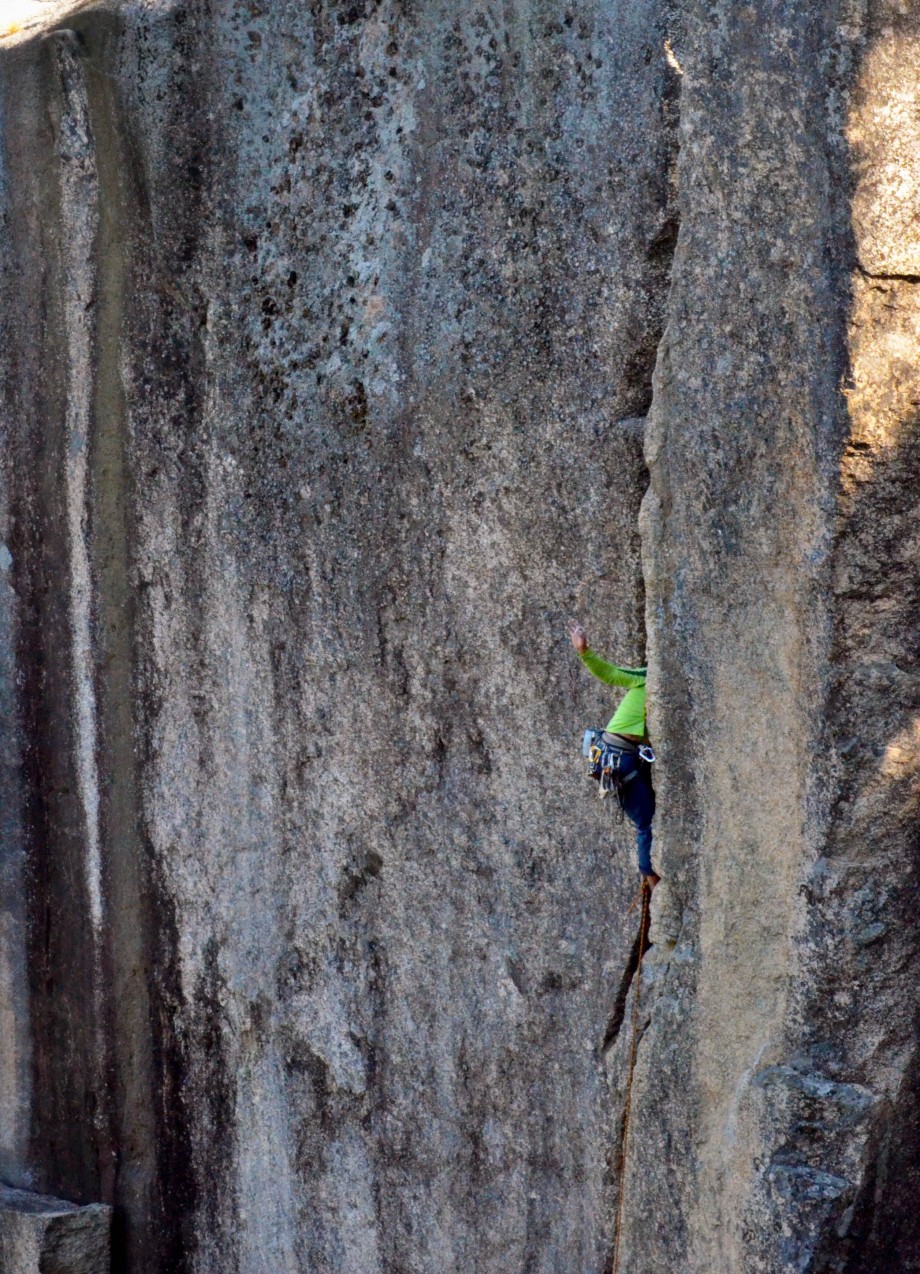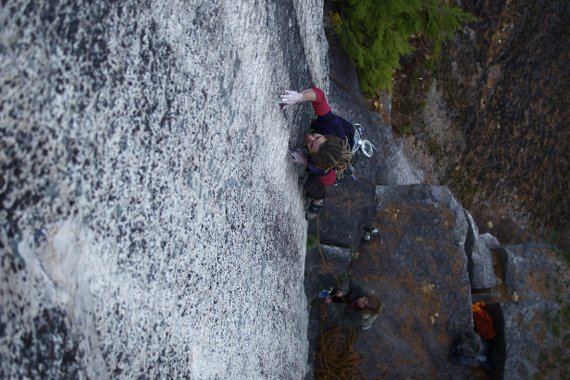Photo: Kevin Boyko
Considering your entry into the world of crack climbing? Then make sure to learn these 10 quick tips brought you by crack addict, Kevin Boyko, as you begin your journey into this technical style of climbing. You may also consider checking out How to Build a Trad Rack and other related articles at the bottom of this post.
1. Be proactive and tape up!
Use tape if your skin is getting torn or for the added friction in slicker cracks. Unprotected is always preferred, but sometimes you gotta wrap it!
Ideal for protecting your skin against sharp cracks (like in Moab) or harsh granite found in destinations like Joshua Tree, tape gloves can make your crack climbing adventures a far more enjoyable and painless experience.
Rather than waiting until after you’ve bled all over the rock and turned your hands into decrepit limbs, simply prepare yourself for the elements with a bit of climbing tape coverage. This can make a major difference in how great your hand jams feel over the course of the day. So avoid unnecessary gobies when possible, and protect yourself. Just make sure you don’t tape too tightly!
Learn how to make your own tape gloves from Tom Randall and Pete Whittaker:
2. I know it hurts! That’s how you know the jam is good
Feeling comfortable on cracks takes time and practice. This inherently means you’ll feel awkward and experience some pain in the process.
Over time, as you deepen your understanding of how to best use your feet and position your body, this style of climbing will become a better friend to you. The pain should diminish with the more cracks you get on and as you find the sizes that suit you best. So get out there and overcome the initial period of pain because the reward of fun is well worth it.
3. Master all the tricks.
Jams come in different flavors and there always should be another trick up your sleeve: thumb up, thumb down, hand stacks, finger locks, fists, side-fists, ring locks, chicken wings, knee bars, shoulder bar, lay-backing, etc … Master them all.
Like most things in life, you can’t master it until you try it. And in the wide and diverse realm of this climbing style, there is always something to improve upon. You’ll need to approach finger cracks, hand cracks, fist cracks, and off-widths in entirely different ways. Essentially, every crack will ask something else of you and your body, so learn and practice these techniques so that no matter the size, you can muster your way to the top.
Finger cracks:
Hand cracks:
Fist cracks:
4. Nail your footwork.
Focus on easy-to-miss constrictions to wedge above. Torquing into a solid foot jam may be painful, but it’s worse for your foot to slide once weighted.
Whenever you embark on a crack, consider how and where your feet can be used. Footwork on crack seams is perhaps the most difficult, yet important aspects to master. Use these vital limbs of yours to support as much of your weight as possible in order to alleviate the pain and pressure on your hands or fingers. Proper footwork will lend itself to more stability and quicker movement up the crack.
Practice first on hand and fist cracks, as they tend to be closer to the size of your foot. Work on learning to slot your feet into the crack, torquing your knee inward, using your waist to raise your legs, weighing your feet, and pushing with your legs rather than relying on your arms to propel you upward.
This steady pattern of movement will eventually feel more natural … just avoid getting your foot stuck as it makes for an incredibly uncomfortable situation.
5. When performed correctly, jams should require little strength and offer a lot of resting opportunity.
Crack climbing can require loads of energy as these routes demand sustained effort, so understanding how to finesse yourself into comfort when available, will help you significantly in the long run.
As you move, seek out features on the rock that provide a traditional rest position or constrictions that enable a more skeletal and less muscular-dependent lock or jam.
 In wider cracks, especially, you should be able to find ample positions in which to wedge your body and take a solid breather. This is a perfect place to experiment with knee jams and knee bars, and if it opens up wide enough, you can even squeeze in a trusty butt jam.
In wider cracks, especially, you should be able to find ample positions in which to wedge your body and take a solid breather. This is a perfect place to experiment with knee jams and knee bars, and if it opens up wide enough, you can even squeeze in a trusty butt jam.
6. You will never be faster than when cruising “your size;” but once in your anti-style, it could take an eternity to move a meter!
Some sizes will feel awful and impossible. Be patient and work with the crack at hand.
7. Nobody wants to be the “offwidth” person … So be a hero and lead the next pitch.
Too big for single hands or fists but not large enough to shove your body in, the offwidth is one of the most hated crack sizes of all. However, if you’re a badass offwidth outlaw, like Pamela Shanti Pack—you know how to master and love all of the arm bars and chicken wings this style calls for.
This technique will also ask for some painful footwork, but offwidths are all about perseverance and dedication, so get yourself through it!
Learn basic offwidth technique:
8. Don’t worry, it will fit.
When there’s a will, there’s a way! No matter the size of the crack, there’s a method of jamming or locking suited for you that can make sending possible.
The more cracks you climb, the more familiar you will become with which technique you must employ on the varying sizes you face. It’s also vital to practice these skills to understand what type of gear you will need for each.
When it comes to tip cracks, in which you can only squeeze in about up to your first knuckle, you can count on needing to whip out your nuts and small cams for protection. These cracks tend to be quite strenuous, as feet can be exceptionally difficult to find!
For great finger cracks with secure locks that match an “average” finger size, expect to use Black Diamond Camalot #.3s-.4s, while “rattly” fingers that are a bit too big for good locks will call for #.5-.75’s.
Thin hand cracks—in which you can get most of your hand into but not quite a solid hand jam—generally lend themselves to a BD Camalot #1, while “perfect” hands for most climbers tend to fit a #2 just right.
For wider or cupped hands, #3s should do the trick. Fists roughly call for a Camalot #4.
Watch tips for gear placement on crack climbs from Tom Randall:
9. Cracks are unique to every climber and every hand size. One person’s 5.8 is another’s 5.11. Use your strengths and work on your weaknesses.
Don’t be disheartened—especially when it comes to climbing grades attributed to crack routes. This style of climbing is especially hard to set a difficulty for, as it is extremely dependent on hand and overall body size. Just because your partner can easily hand jam his/her way up a route, doesn’t mean you’ll get benefit from the same “perfect” hand size on that climb.
Technique is key, and if you master your own methods for tackling different sizes, you can rely less on grades to guide the cracks you seek to climb.
10. I know it hurts! Stop being a baby.
Get out there, try really, really hard, and have fun. Eventually, it won’t hurt so bad and you’ll become the master crack climber you’ve always aspired to become.
This article was originally published on February 23, 2015.
If you liked this article, we think you’ll also enjoy:
- How to Tape for Crack Climbing
- Addicted to Cracks: 10 American Climbs Worth Jamming Into
- Five Yoga Poses for Crack Climbing Performance
- How to Build Your First Trad Rack
- Cam Range Comparisons for Trad Gear
Lastly, don’t forget to check out our most popular articles ever published, free rock climbing eBooks, and the internet’s best climbing gear sales.








